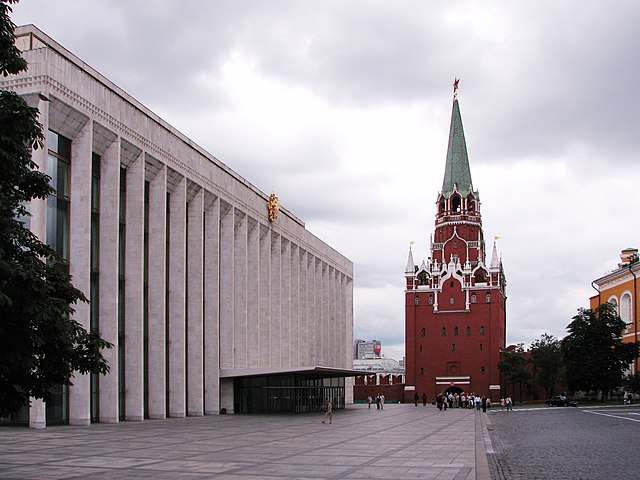Top Qs
Timeline
Chat
Perspective
Soviet architectural modernism
Architectural style From Wikipedia, the free encyclopedia
Remove ads
Soviet architectural modernism was one of the three main architectural trends of the USSR, along with Soviet avant-garde architecture and Stalinist Empire style. Critics identified it in the early 21st century as a separate direction. It covered the period from 1955 to 1991. The transition to modernism began with the resolution of the CPSU Central Committee and the Council of Ministers of the USSR of 4 November 1955, "On the Elimination of Excesses in Design and Construction."[1]




Remove ads
General characteristics
Summarize
Perspective
Origins
Architectural modernism came to the USSR from the West and transformed into a Soviet form. During the so-called Khrushchev Thaw, specialized professional journals became openly accessible to Soviet architects, and exchanges of experience began with architects from Poland, Cuba, and the Hungary. The international character of modernism was, in fact, one of its main distinguishing features.
More specifically, the origins of Soviet modernism lay directly in the works of Le Corbusier, who by the 1950s had reworked the foundations of Soviet constructivism into a new, personal architectural style.
History of the term
The term "Soviet architectural modernism" was introduced in the early 2010s. Before that, it essentially did not exist. There are still no precise criteria defined for Soviet architectural modernism, other than the relatively clear chronological period.
A significant role in identifying this style was played by French photographer Frédéric Chaubin,[2] who, in the early 2000s, traveled through the former Soviet Union and documented a number of buildings, which at that time were considered exclusively examples of brutalism.
Soviet architectural modernism and brutalism
According to many researchers, Brutalism formed the basis of Soviet modernism.[3]
For Soviet modernism, as well as for brutalism, functionality of massive forms and constructions was characteristic, as well as the urban appearance of buildings. Compositional solutions were probably intended to reflect the scope of advanced ideas and the anti-bourgeois principles of Soviet life. As in brutalism, the main building material of Soviet modernism was reinforced concrete, and the approach to architectural commissions was comprehensive.
Stylistic features
It would, however, be incorrect to fully equate this architectural style with brutalism, since there were differences. For example, a feature of Soviet modernism was the use of facing materials (marble, sandstone, shell limestone, ceramics, and others).
Another characteristic of this style (especially in its developmental stage) was decorativeness—for instance, mosaic panels, bas-reliefs, and other modernist decorative elements of monumental art. Mass glazing of building surfaces was also typical, partly reminiscent of constructivism.
Remove ads
Research
A significant role in defining the style was played by the study (in fact, a photo album) of French photographer Frédéric Chaubin, as well as the photo series "Spomenik" by Belgian photographer Jan Kempenaers.[4]
In this context, attention should also be given to the study of architect Felix Novikov, published by Tatlin Publishing under the title "Soviet Modernism: 1955–1985,"[5] as well as the work on the creativity of Armenian architects "Architecture of Soviet Modernism."[6]
Remove ads
Main examples of the style
Examples of Soviet modernism included the following buildings: Great Moscow State Circus,[7] Pavilion No. 70 "Moscow" at VDNH, Moscow Palace of Pioneers,[8] the State Kremlin Palace,[9] the ensemble of Victory Park on Poklonnaya Hill,[10] Ostankino Tower,[11] the residential district Chertanovo Severnoye, the AZLK Museum building, the Central Wedding Palace, and the branch of the Central Museum of V. I. Lenin in Kyiv, among others.
- Great Moscow State Circus. Architects: E. Vulikh and L. Misozhnikov, consultants Ya. Belopolsky and N. Kancheli
- Comecon "Book". Architects M. V. Posokhin, A. A. Mndoyants
- Moscow Palace of Pioneers
- Pavilion No. 70 "Moscow" at VDNH. Architects M. V. Posokhin, A. A. Mndoyants, B. Tkhor
- Druzhba Sanatorium, Yalta. Architect: I. Vasilevsky
- Rosstat Tower, Izmaylovskoye Highway, 44
- Yerevan Youth Palace
- Laboratory tower of the Central Research Institute of Robotics and Technical Cybernetics
- Pulkovo Terminal ("Five Glasses")
Criticism of the style
The main criticism of this architectural style was that after the Stalinist "decorativeness," the purely functional austerity of modernism (starting in the Khrushchev era) deprived architects of creative freedom. As for the views of ordinary citizens, many Soviet people were dissatisfied with the so-called "box houses," which they considered lacking cultural and artistic value.
Furthermore, the art of this period in general, and architecture in particular, was characterized by a formal approach and adherence to ideological guidelines.
Thus, in an open letter to Mikhail Suslov, a group of artists from the circle of E. M. Belyutin criticized the formal approach to art and the practice of creating works of art within the framework of state commissions.
Remove ads
See also
- Khrushchyovka
- Tsekhovsky House
- Housing construction in the Soviet Union
References
Literature
Wikiwand - on
Seamless Wikipedia browsing. On steroids.
Remove ads











